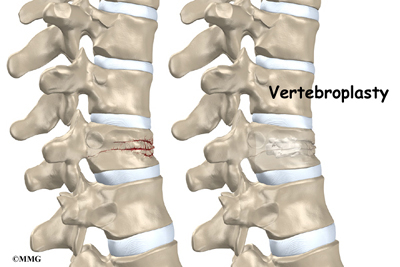VERTEBROPLASTY

The goals of the vertebroplasty surgical procedure are to stabilize the spinal fracture and to stop the pain caused by the fracture. Vertebroplasty is considered a minimally invasive surgical procedure because the procedure is done through a small puncture in the patient's skin (as opposed to an open incision). A typical vertebroplasty procedure, described below, usually takes about 1 hour to complete
The patient is treated with local anesthesia and light sedation, usually in an x-ray suite or operating room on an outpatient basis. A biopsy needle is guided into the fractured vertebra under X-ray guidance through a small puncture in the patient's skin. Specially formulated acrylic bone cement is injected under pressure directly into the fractured vertebra, filling the spaces within the bone - with the goal of creating a type of internal cast (a cast within the vertebra) to stabilize the vertebral bone. The needle is removed and the cement hardens quickly (about 10 minutes), congealing the fragments of the fractured vertebra and stabilizing the bone. The small skin puncture is covered with a bandage Shortly after the cement has hardened, the patient is free to leave the medical facility and can go home the same day. Patients are usually advised not to drive themselves home the day of the procedure, and may need to spend the night at a hotel in the area if they have to travel a long distance. If the patient needs further observation after the procedure, is particularly frail, or will not have assistance at home, a short stay in the hospital may be recommended.
For the first 24 hours after vertebroplasty, bedrest is usually recommended. Activities may be increased gradually and most regular medications can be resumed. There may be some soreness for a few days at the puncture site which may be relieved with an ice pack.
Many patients undergoing percutaneous vertebroplasty experience 90 percent or better reduction in pain within 24-48 hours and increased ability to perform daily activities shortly thereafter. Recent research has demonstrated that percutaneous vertebroplasty can relieve pain from vertebral compression fractures for up to nearly three years following the procedure.